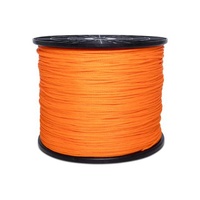
Wattmaster WATPL1000M | Pull Line Rope Orange 3mm x Length 1000m | 90kg Breaking Strain
$66.00
$60.00 ex. GST
Search Results:
Search Results:

Wattmaster WATPL1000M | Pull Line Rope Orange 3mm x Length 1000m | 90kg Breaking Strain
$66.00
$60.00 ex. GST

NLS 30130 | Heavy Duty SOLAR Corrugated Conduit Grey 32mm 25 mtr roll | Budget Range
$63.47
$57.70 ex. GST
Corrugated conduit is used to conceal or provide mechanical protection for cables.
The product is designed to be easy to install, reduce job time, and use fewer fittings than other products. It is made from PVC with a flame retardant and meets AS/NZS2053 requirements.
A corrugated conduit roll is a flexible conduit that allows for easy installation and is commonly used in various applications, including above-ground and underground use. The medium-duty grey material is typically used for above ground installations, while the heavy-duty orange material is required for underground installations.
Electricians and tradespeople tend to use corrugated conduit because it is easy to install, extremely versatile and weatherproof. It can be used for above-ground and underground installations, making them the perfect choice for various projects. Corrugated conduits are a low cost-effective solution to cable protection.
25 mm corrugated conduit is the most common size sold. 25mm is wide enough to fit a variety of different size cables such as building wire, SDI or TPS (thermoplastic-sheathed).
Corrugated conduit comes in 20mm, 25mm, 32mm, 40mm, 50mm in orange (heavy-duty underground) and grey (medium-duty above ground).
We stock quality brands like Clipsal Turbo corrugated conduit and NLS corrugated conduit inc NLS Solar Heavy Duty corrugated conduit.
Conduits can be joined with corrugated conduit fittings and accessories such as couplings, junction boxes, tee junctions, plain to screw adapters. It is best practice to glue the conduits together to prevent moisture from entering and maintain the sealed conduits' protection levels.
Corrugated conduit glue is available as clear glue or blue glue. This glue is typically sold in 250ml or 500ml bottles.
Corrugated conduits are commonly mounted to walls or ceiling surfaces using either half metal saddles or full metal saddles.
If the conduit is installed in corrosive locations like a beach or near chemicals, many installers will use PVC saddles or galvanised saddles to prevent corrosion.
Saddles are spaced evenly along the length of the corrugated conduit to prevent sagging. (approximately 30cm apart) The saddles are fixed to the wall with either nylon nail in anchors (knock-ins) or green wall plugs and screws.
Many tradespeople choose to use lubricant when installing cables in a conduit. Lubricant helps the cables move smoothly and prevents damage from occurring.
To run the cables inside a corrugated conduit, use a pull-through snake or fish tape.
Some professionals use a vacuum and cable pull line rope to first pull a pull wire through the installed corrugated conduit, and then they tie the cable to the pull line rope to securely get the cable through.
As per AS3000:2018, you can fit 2 x 1.5 PVC/PVC V90 Flat twin and earth cables into a 25mm medium-duty grey conduit; please use the graph below as a reference.

A set of heavy-duty conduit cutters is the easiest way to cut corrugated conduit. They are ergonomically designed for the job and can be carried around in a tool belt or bag. They are safe to use and will last many years.
For those who only need to cut corrugated conduit a few times, use a utility type knife or hacksaw.
Using corrugated conduit is a great way to protect your electrical wires from heat and cold. It is easy to install and comes in a variety of sizes. Make sure you follow the guidelines above when installing to get the best results.

Hi there, how can we help you?